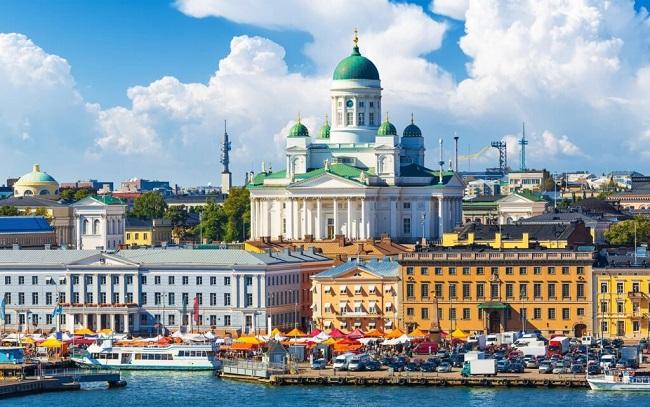Finland, known for its vast wilderness, serene lakes, and vibrant urban centers, offers visitors an exceptional blend of natural beauty and cultural richness. With its unique Nordic charm, every corner of Finland presents an opportunity for discovery, from the bustling streets of Helsinki to the tranquil Arctic landscapes.
This article uncovers the top 10 most visited places in Finland, highlighting the distinctive features and experiences each destination provides.
Whether you’re in search of the spectacular Northern Lights, seeking adventure in the great outdoors, or exploring historic sites, Finland’s top attractions are sure to leave a lasting impression.

Top 10 Most Visited Places in Finland
1: Helsinki:
Finland’s capital and largest city, Helsinki, is celebrated for its design, architecture, and maritime allure. Key attractions include the Suomenlinna Sea Fortress, the Helsinki Cathedral, and the vibrant Design District.
2: Rovaniemi and the Arctic Circle:
Known as the official hometown of Santa Claus, Rovaniemi is a gateway to Arctic adventures, offering magical experiences like viewing the Northern Lights and husky sledding.
3: Turku:
As the oldest city in Finland, Turku is rich in history and culture, featuring the Turku Castle, the Turku Cathedral, and a beautiful archipelago that can be explored by ferry.
4: Tampere:
Situated between two lakes, Tampere has a lively cultural scene, with attractions such as the Tampere Cathedral, the Vapriikki Museum Centre, and the Särkänniemi Amusement Park.
5: Savonlinna:
Home to the medieval Olavinlinna Castle, Savonlinna is nestled in the heart of the Saimaa lake region and is famous for its annual Opera Festival.
6: Porvoo:
One of the six medieval towns in Finland, Porvoo charms visitors with its cobblestone streets, old wooden houses, and the Porvoo Cathedral. The town’s riverside setting adds to its picturesque beauty.
7: Åland Islands:
An autonomous archipelago between Finland and Sweden, the Åland Islands offer a unique blend of Finnish and Swedish cultures, stunning maritime landscapes, and outdoor activities.
8: Kuusamo and Oulanka National Park:
This area is a paradise for nature lovers, featuring the stunning Oulanka National Park with its hanging bridges, rapids, and hiking trails, as well as opportunities for bear watching and white-water rafting.
9: Levi and Ylläs:
These ski resorts in Finnish Lapland are not just for winter sports; they provide year-round activities, including hiking, mountain biking, and the chance to experience the midnight sun.
10: Lake Saimaa and Linnansaari National Park:
The Saimaa lake system is the largest in Finland and is an ideal spot for canoeing, fishing, and spotting the rare Saimaa ringed seal. Linnansaari National Park offers excellent facilities for visitors to enjoy the lake’s natural beauty.
Conclusion:
Finland’s top 10 most visited places offer a remarkable array of experiences, from urban exploration in historical cities to immersive nature encounters in the country’s vast wilderness.
Each destination tells a story of Finland’s heritage, innovation, and the deep connection Finns have with their natural environment.
Embarking on a journey to these Finnish highlights, travelers can expect to engage with friendly locals, embrace the peaceful Nordic lifestyle, and create memories that resonate with the tranquility and beauty of Finland.
FAQ: Top 10 Most Visited Places in Finland
Q1: What is the best time of year to visit Finland?
A1: The best time to visit Finland depends on the activities you’re interested in. For summer activities and the midnight sun, June to August is ideal. For winter sports and the Northern Lights, visit between December and March.
Q2: Do I need a visa to visit Finland?
A2: Finland is part of the Schengen Agreement. Visitors from Schengen countries can enter without a visa for short stays. For visitors from outside the Schengen Area, whether you need a visa depends on your nationality.
It’s essential to check the current visa requirements on the official website of Finland’s Ministry for Foreign Affairs.
Q3: Can I see the Northern Lights anywhere in Finland?
A3: The Northern Lights can be seen in Finland, typically in Lapland, the northernmost part of the country, during the winter months from September to March. Rovaniemi is a popular destination for Northern Lights viewing.
Q4: What is the currency in Finland?
A4: The currency used in Finland is the Euro (€). Credit cards are widely accepted, but it’s always good to carry some cash, especially when visiting smaller towns or rural areas.
Q5: What are some traditional Finnish foods I should try?
A5: Traditional Finnish foods to try include Karjalanpiirakka (Karelian pies), Ruisleipä (rye bread), Poronkäristys (sauteed reindeer), Lohikeitto (salmon soup), and Mustikkapiirakka (blueberry pie).
Q6: What is the best way to travel around Finland?
A6: Finland has a comprehensive public transportation system including trains and buses, which are efficient ways to travel between major cities. For more remote areas, renting a car may be more convenient.
Q7: What are the typical customs and etiquette in Finland?
A7: Finns value punctuality, honesty, and directness. Small talk is not as common as in some other cultures, and silence is often appreciated. When using saunas, which are an integral part of Finnish culture, nudity is normal, and it’s considered a place for relaxation and quiet.
Q8: Is tap water safe to drink in Finland?
A8: Yes, tap water is safe to drink in Finland and is among the cleanest in the world.
Q9: What should I pack for a trip to Finland?
A9: For a trip to Finland, pack according to the season. In winter, bring warm clothing, thermal layers, and good-quality winter boots. In summer, pack lighter clothing but also include a jacket for cooler evenings. Don’t forget swimwear for the sauna!
Q10: Are tourist sites in Finland accessible for visitors with disabilities?
A10: Finland is generally very accessible for visitors with disabilities. Most public buildings, transport, and major tourist attractions are equipped with facilities for disabled access.
However, it’s always a good idea to check with specific places in advance to ensure they can accommodate your needs.


















































